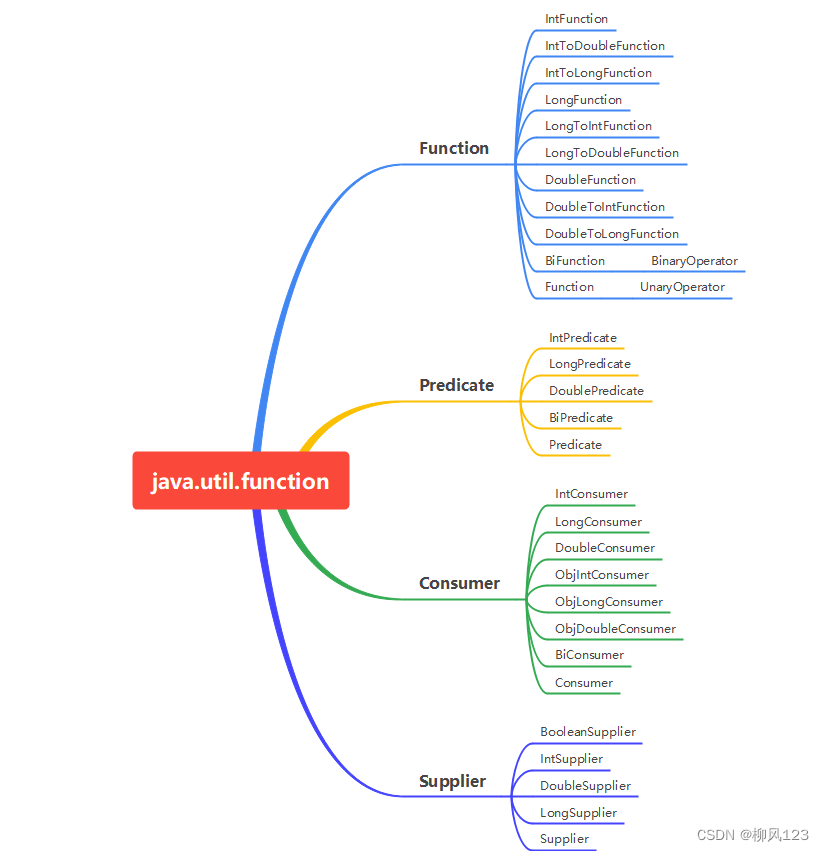文章目录
函数式接口定义
a functional interface has exactly one abstract method. Since default methods have an implementation, they are not abstract
If an interface declares an abstract method overriding one of the public methods of java.lang.Object, that also does not count toward the interface’s abstract method count since any implementation of the interface will have an implementation from java.lang.Object or elsewhere.
Note that instances of functional interfaces can be created with lambda expressions, method references, or constructor references.
函数式接口的概念(Functional Interface)就是只包含一个抽象方法的接口。 这类接口可以使用 lambda表达式, 方法引用,构造函数引用。
如果这个接口定义的抽象方法覆盖了 Object类的某个public方法,这个抽象方法不会被统计为抽象方法。
前面提到JAVA8以后接口支持默认方法,默认方法并非是抽象方法(有方法体),所以不会影响lambda表达式使用。
java8 中还提供刻一个注解 @FunctionalInterface, 该注解就是标识接口是函数式接口。使用该注解是一种语法规范,约束该接口只有一个抽象方法,如果该类存在多个抽象方法,编译器会立刻抛出错误提示。 但是不代表不使用该注解的接口就一定标记为非函数式接口
内置的函数式接口
java8中提供了,默认方法。但是如果只存在一个抽象方法,它依旧属于函数型接口。 在包 java.util.function 下提供了很多内置的函数式接口。

Function
@FunctionalInterface
public interface Function<T, R> {
R apply(T t);
default <V> Function<V, R> compose(Function<? super V, ? extends T> before) {
Objects.requireNonNull(before);
return (V v) -> apply(before.apply(v));
}
default <V> Function<T, V> andThen(Function<? super R, ? extends V> after) {
Objects.requireNonNull(after);
return (T t) -> after.apply(apply(t));
}
static <T> Function<T, T> identity() {
return t -> t;
}
}
可以看到抽象方法是 apply, 其他方法是默认方法,静态方法(存在方法体)。 同时使用了@FunctionalInterface。
apply
通常我们用到的就是apply方法,这是一个抽象方法,通过重写该方法实现自定义的逻辑。
// 匿名内部类的方法创建 Function的对象
Function<String,Integer> function = new Function<String, Integer>() {
@Override
public Integer apply(String s) {
return Integer.valueOf(s);
}
};
//调用
System.out.println(function.apply("1234"));
上面提到了函数式接口可以使用 lambda表达式,简化后
Function<String,Integer> function = s -> Integer.valueOf(s);
使用lambda 方法引用。
Function<String, Integer> function = Integer::valueOf;
Optional 类中,存在一个实例方法map, 可以将结果转化。就用到了Function, 接收一个入参,一个返回值。
public<U> Optional<U> map(Function<? super T, ? extends U> mapper) {
if (!isPresent())
return empty();
else {
return Optional.ofNullable(mapper.apply(value));
}
}
示例: 将字符串转化为 整数类型
Optional<String> stringOptional = Optional.of("12");
Optional<Integer> integerOptional = stringOptional.map(Integer::valueOf);
System.out.println(integerOptional.get());
andThen
可能会存在某种场景, 我们需要对操作的结果 做进一步的处理。
Function<String, Integer> function = s -> Integer.valueOf(s);;
// 字符串 转为数字类型后,我需要加10
Function andThenFunction = function.andThen(new Function<Integer, Integer>() {
@Override
public Integer apply(Integer integer) {
return integer + 10;
}
});
// 当然了,还可以继续, 做其他处理
System.out.println(andThenFunction.apply("10"));
输出结果:
20
default <V> Function<T, V> andThen(Function<? super R, ? extends V> after) {
Objects.requireNonNull(after);
return (T t) -> after.apply(apply(t));
}
这个是一个默认方法。
根据上面的例子,我们在代码中创建了两个Function实例。 再看定义, 内部又创建了一个新的Function实例。
default <V> Function<T, V> andThen(Function<? super R, ? extends V> after) {
return new Function<T, V>() {
@Override
public V apply(T t) {
return after.apply(apply(t));;
}
};
}
里面的处理逻辑,先执行调用andThen的Function,apply返回值作为入参 传递到 after.apply中, after的返回值作为最终结果。
compose 函数功能类似,区别在于。这个是compose传入的函数,在 apply 之前执行。
default <V> Function<V, R> compose(Function<? super V, ? extends T> before) {
Objects.requireNonNull(before);
return (V v) -> apply(before.apply(v));
}
identity
/**
* Returns a function that always returns its input argument.
*
* @param <T> the type of the input and output objects to the function
* @return a function that always returns its input argument
*/
static <T> Function<T, T> identity() {
return t -> t;
}
首先是一个静态方法, 其次 内部是一个lambda表达式。 第一次看源码的时候,特别懵逼,鬼知道这是什么意思。
我们不妨看一下注释, 返回一个函数,这个函数的返回值始终为传入参数。 上面我们也看到了apply的lambda 表达式的简化写法。
与下面的写法等价
static <T> Function<T, T> identity() {
return new Function<T, T>() {
@Override
public T apply(T t) {
return t;
}
};
}
BiFunction
BiFunction 与Function 功能类似,区别就是有两个入参。
@FunctionalInterface
public interface BiFunction<T, U, R> {
R apply(T t, U u);
default <V> BiFunction<T, U, V> andThen(Function<? super R, ? extends V> after) {
Objects.requireNonNull(after);
return (T t, U u) -> after.apply(apply(t, u));
}
}
Consumer
@FunctionalInterface
public interface Consumer<T> {
void accept(T t);
default Consumer<T> andThen(Consumer<? super T> after) {
Objects.requireNonNull(after);
return (T t) -> { accept(t); after.accept(t); };
}
}
抽象方法 accept, 一个入参无返回值。
accept
Consumer<String> consumer = new Consumer<String>() {
@Override
public void accept(String s) {
System.out.println(s);
}
};
consumer.accept("Hello World");
输出结果:
Hello World
lambda表达式:
Consumer<String> consumer = s -> System.out.println(s);
方法引用:
Consumer<String> consumer = System.out::println;
在接口List中存在元素遍历的方法,【forEach】。 它接收的参数就是 Consumer。
核心代码如下:
public void forEach(Consumer<? super E> action) {
// 获取 List中的元素
final E[] elementData = (E[]) this.elementData;
final int size = this.size;
for (int i=0; i < size; i++) {
// 遍历
action.accept(elementData[i]);
}
}
比如要遍历集合的元素, 比较简单的写法:
List<Integer> list = new ArrayList();
list.forEach(System.out::println);
BiConsumer
接收两个入参:
@FunctionalInterface
public interface BiConsumer<T, U> {
void accept(T t, U u);
default BiConsumer<T, U> andThen(BiConsumer<? super T, ? super U> after) {
Objects.requireNonNull(after);
return (l, r) -> {
accept(l, r);
after.accept(l, r);
};
}
}
Supplier
@FunctionalInterface
public interface Supplier<T> {
/**
* Gets a result.
*
* @return a result
*/
T get();
}
Supplier 属于 内置的函数式接口比较好理解的。 无参,有个返回值。
Optional 类中存在实例方法,用于返回默认值。
public T orElse(T other) {
return value != null ? value : other;
}
public T orElseGet(Supplier<? extends T> other) {
return value != null ? value : other.get();
}
orElseGet 方法就用到了 Supplier接口。
Optional<List> optional = Optional.ofNullable(null);
List list = optional.orElseGet(() -> new ArrayList());
System.out.println(list);
返回结果:
[]
Predicate
Predicate 中的方法比较多,and、or、notEqual
@FunctionalInterface
public interface Predicate<T> {
boolean test(T t);
default Predicate<T> and(Predicate<? super T> other) {
Objects.requireNonNull(other);
return (t) -> test(t) && other.test(t);
}
default Predicate<T> negate() {
return (t) -> !test(t);
}
default Predicate<T> or(Predicate<? super T> other) {
Objects.requireNonNull(other);
return (t) -> test(t) || other.test(t);
}
static <T> Predicate<T> isEqual(Object targetRef) {
return (null == targetRef)
? Objects::isNull
: object -> targetRef.equals(object);
}
}
Predicate 的 默认方法因为没有各种嵌套,所以看起来就直观很多。
比如 Optionnal中的filter 方法就使用到了 Predicate
public Optional<T> filter(Predicate<? super T> predicate) {
Objects.requireNonNull(predicate);
if (!isPresent())
return this;
else
return predicate.test(value) ? this : empty();
}
Optional<String> strOptional = Optional.of("12");
boolean isPresent = strOptional.filter(StringUtils::isEmpty).isPresent();
System.out.println(isPresent);
false





















 680
680











 被折叠的 条评论
为什么被折叠?
被折叠的 条评论
为什么被折叠?








